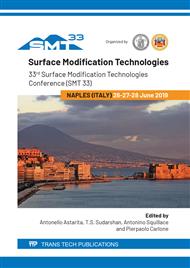p.37
p.43
p.49
p.55
p.62
p.68
p.74
p.80
p.86
Influence of Applied CrN+WC/C and WC/C Coatings on the Cavitation Wear Processes of Constructional Elements
Abstract:
When designing the individual subassemblies of machines or entire devices one has to draw special attention to the resistance of the elements working there, to tribological damages (mechanical, fatigue, adhesion, abrasion, hydrogen and other damages) as well as to non-tribological damages (corrosion, diffusion, cavitation, erosion, ablation and others). The main purpose of this publication was to examine the influence of the applied CrN+WC/C and WC/C protective coating deposited by PVD (Physical Vapour Deposition) method on the cavitation wear processes of construction elements working in difficult cavitation environment. Two steels were selected for detailed examinations in the conditions of cavitation wear. The first one is P265GH steel commonly used for pressure devices working at elevated temperatures, with a ferritic – pearlitic structure, and the other derives from a group of stainless steels, i.e. chromium – nickel X2CrNi18-9 (304L) steel with an austenitic structure. The tests results obtained allow to conclude that the application of special low – friction protective coatings allows to reduce costs associated with selection of engineering materials for a substrate of constructional elements working in a cavitation wear environment. P265GH steel is 4.5 times cheaper than austenitic chromium – nickel X2CrNi18-9 (304L) steel, and if a CrN+WC/C and WC/C coating is deposited in this case, this considerably extends the working time of such elements in a cavitation environment.
Info:
Periodical:
Pages:
62-67
Citation:
Online since:
July 2019
Authors:
Price:
Сopyright:
© 2019 Trans Tech Publications Ltd. All Rights Reserved
Share:
Citation:


